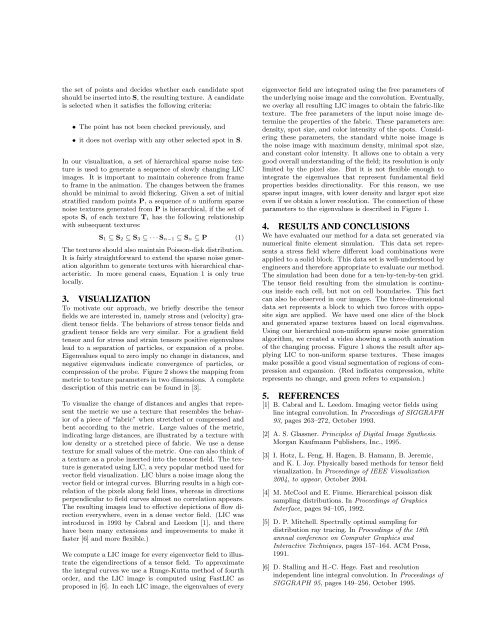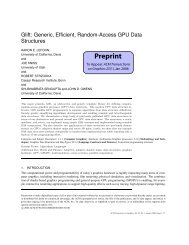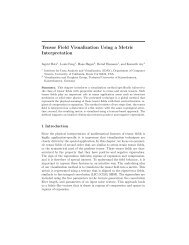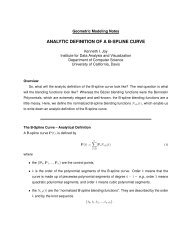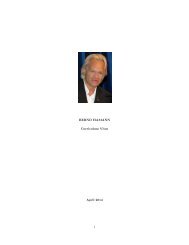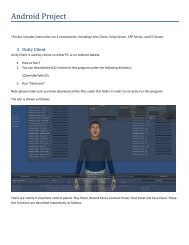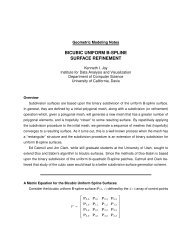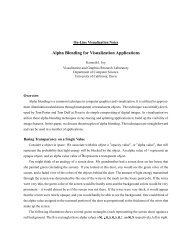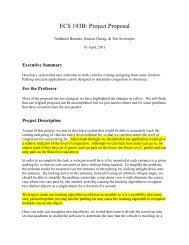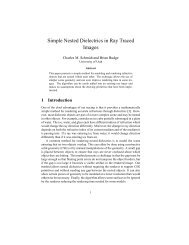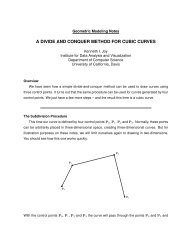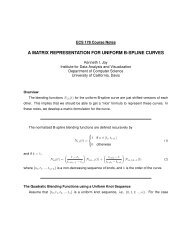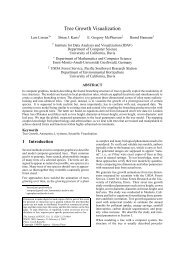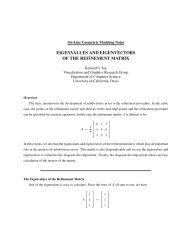Texture Animation for Tensor Field Visualization - CiteSeerX
Texture Animation for Tensor Field Visualization - CiteSeerX
Texture Animation for Tensor Field Visualization - CiteSeerX
You also want an ePaper? Increase the reach of your titles
YUMPU automatically turns print PDFs into web optimized ePapers that Google loves.
the set of points and decides whether each candidate spot<br />
should be inserted into S, the resulting texture. A candidate<br />
is selected when it satisfies the following criteria:<br />
• The point has not been checked previously, and<br />
• it does not overlap with any other selected spot in S.<br />
In our visualization, a set of hierarchical sparse noise texture<br />
is used to generate a sequence of slowly changing LIC<br />
images. It is important to maintain coherence from frame<br />
to frame in the animation. The changes between the frames<br />
should be minimal to avoid flickering. Given a set of initial<br />
stratified random points P, a sequence of n uni<strong>for</strong>m sparse<br />
noise textures generated from P is hierarchical, if the set of<br />
spots S i of each texture T i has the following relationship<br />
with subsequent textures:<br />
S 1 ⊆ S 2 ⊆ S 3 ⊆···S n−1 ⊆ S n ⊆ P (1)<br />
The textures should also maintain Poisson-disk distribution.<br />
It is fairly straight<strong>for</strong>ward to extend the sparse noise generation<br />
algorithm to generate textures with hierarchical characteristic.<br />
In more general cases, Equation 1 is only true<br />
locally.<br />
3. VISUALIZATION<br />
To motivate our approach, we briefly describe the tensor<br />
fields we are interested in, namely stress and (velocity) gradient<br />
tensor fields. The behaviors of stress tensor fields and<br />
gradient tensor fields are very similar. For a gradient field<br />
tensor and <strong>for</strong> stress and strain tensors positive eigenvalues<br />
lead to a separation of particles, or expansion of a probe.<br />
Eigenvalues equal to zero imply no change in distances, and<br />
negative eigenvalues indicate convergence of particles, or<br />
compression of the probe. Figure 2 shows the mapping from<br />
metric to texture parameters in two dimensions. A complete<br />
description of this metric can be found in [3].<br />
To visualize the change of distances and angles that represent<br />
the metric we use a texture that resembles the behavior<br />
of a piece of “fabric” when stretched or compressed and<br />
bent according to the metric. Large values of the metric,<br />
indicating large distances, are illustrated by a texture with<br />
low density or a stretched piece of fabric. We use a dense<br />
texture <strong>for</strong> small values of the metric. One can also think of<br />
a texture as a probe inserted into the tensor field. The texture<br />
is generated using LIC, a very popular method used <strong>for</strong><br />
vector field visualization. LIC blurs a noise image along the<br />
vector field or integral curves. Blurring results in a high correlation<br />
of the pixels along field lines, whereas in directions<br />
perpendicular to field curves almost no correlation appears.<br />
The resulting images lead to effective depictions of flow direction<br />
everywhere, even in a dense vector field. (LIC was<br />
introduced in 1993 by Cabral and Leedom [1], and there<br />
have been many extensions and improvements to make it<br />
faster [6] and more flexible.)<br />
We compute a LIC image <strong>for</strong> every eigenvector field to illustrate<br />
the eigendirections of a tensor field. To approximate<br />
the integral curves we use a Runge-Kutta method of fourth<br />
order, and the LIC image is computed using FastLIC as<br />
proposed in [6]. In each LIC image, the eigenvalues of every<br />
eigenvector field are integrated using the free parameters of<br />
the underlying noise image and the convolution. Eventually,<br />
we overlay all resulting LIC images to obtain the fabric-like<br />
texture. The free parameters of the input noise image determine<br />
the properties of the fabric. These parameters are:<br />
density, spot size, and color intensity of the spots. Considering<br />
these parameters, the standard white noise image is<br />
the noise image with maximum density, minimal spot size,<br />
and constant color intensity. It allows one to obtain a very<br />
good overall understanding of the field; its resolution is only<br />
limited by the pixel size. But it is not flexible enough to<br />
integrate the eigenvalues that represent fundamental field<br />
properties besides directionality. For this reason, we use<br />
sparse input images, with lower density and larger spot size<br />
even if we obtain a lower resolution. The connection of these<br />
parameters to the eigenvalues is described in Figure 1.<br />
4. RESULTS AND CONCLUSIONS<br />
We have evaluated our method <strong>for</strong> a data set generated via<br />
numerical finite element simulation. This data set represents<br />
a stress field where different load combinations were<br />
applied to a solid block. This data set is well-understood by<br />
engineers and there<strong>for</strong>e appropriate to evaluate our method.<br />
The simulation had been done <strong>for</strong> a ten-by-ten-by-ten grid.<br />
The tensor field resulting from the simulation is continuous<br />
inside each cell, but not on cell boundaries. This fact<br />
can also be observed in our images. The three-dimensional<br />
data set represents a block to which two <strong>for</strong>ces with opposite<br />
sign are applied. We have used one slice of the block<br />
and generated sparse textures based on local eigenvalues.<br />
Using our hierarchical non-uni<strong>for</strong>m sparse noise generation<br />
algorithm, we created a video showing a smooth animation<br />
of the changing process. Figure 1 shows the result after applying<br />
LIC to non-uni<strong>for</strong>m sparse textures. These images<br />
make possible a good visual segmentation of regions of compression<br />
and expansion. (Red indicates compression, white<br />
represents no change, and green refers to expansion.)<br />
5. REFERENCES<br />
[1] B. Cabral and L. Leedom. Imaging vector fields using<br />
line integral convolution. In Proceedings of SIGGRAPH<br />
93, pages 263–272, October 1993.<br />
[2] A. S. Glassner. Principles of Digital Image Synthesis.<br />
Morgan Kaufmann Publishers, Inc., 1995.<br />
[3] I. Hotz, L. Feng, H. Hagen, B. Hamann, B. Jeremic,<br />
and K. I. Joy. Physically based methods <strong>for</strong> tensor field<br />
visualization. In Proceedings of IEEE <strong>Visualization</strong><br />
2004, to appear, October 2004.<br />
[4] M. McCool and E. Fiume. Hierarchical poisson disk<br />
sampling distributions. In Proceedings of Graphics<br />
Interface, pages 94–105, 1992.<br />
[5] D. P. Mitchell. Spectrally optimal sampling <strong>for</strong><br />
distribution ray tracing. In Proceedings of the 18th<br />
annual conference on Computer Graphics and<br />
Interactive Techniques, pages 157–164. ACM Press,<br />
1991.<br />
[6] D. Stalling and H.-C. Hege. Fast and resolution<br />
independent line integral convolution. In Proceedings of<br />
SIGGRAPH 95, pages 149–256, October 1995.


